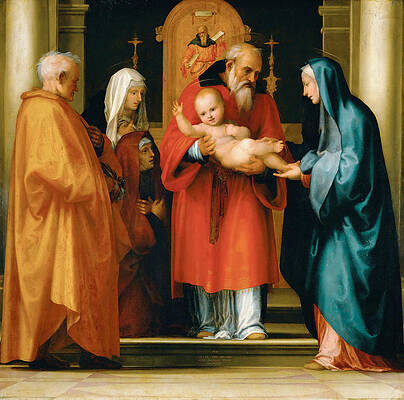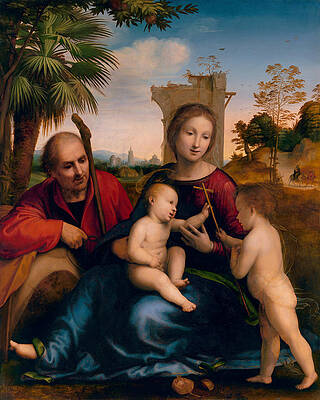Fra Bartolomeo (Bartolomeo di Paolo), also called Baccio della Porta
Paintings
The Nativity
The Madonna and Child with Saint John
Madonna and Child with the Young Saint John the Baptist
The Lying in State and Ascension of Saint Anthonius
The Virgin adoring the Child with Saint Joseph
Saint Jerome in the Wilderness
Head of a Female Saint seen in Profile
Madonna and Child
The Rest on the Flight into Egypt with St. John the Baptist
Madonna and Child with Saint Anne and the Patron Saints of Florence
Holy Family
Portrait of a Man
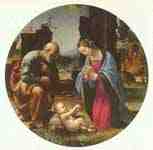
The Adoration of the Child, Tondo

God the Father with Mary Magdalene and Saint Catherine of Siena
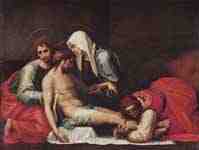
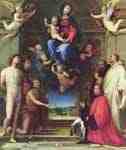
Mary with saints and the founder Jean Carandolet
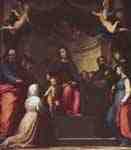
Drawings
Madonna and Child with the Infant Saint John the Baptist and Two Putti


Christ in the Garden of Gethsemane

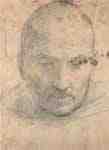
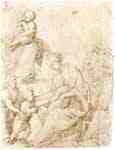
Madonna with the Child Jesus and St. John

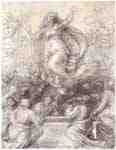
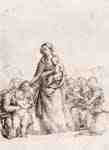
Standing Madonna and Child adored by angels
Fine Art Prints | Greeting Cards | Phone Cases | Lifestyle | Face Masks | Men's , Women' Apparel | Home Decor | jigsaw puzzles | Notebooks | Tapestries | ...
The Nativity
Fra Bartolomeo or Fra Bartolommeo (di Pagholo) OP (March 28, 1472 – October 6, 1517), also known as Baccio della Porta, was an Italian Renaissance painter of religious subjects. He was born in Savignano di Prato, Tuscany. He received the nickname of Baccio della Porta for his house was near the Porta ("Gate") San Pier Gattolini. Starting from 1483 or 1484, by recommendation of Benedetto da Maiano, he apprenticed in the workshop of Cosimo Rosselli. He was one of the greatest painters of his time. In 1490 or 1491 he began a collaboration with Mariotto Albertinelli. In the late 1490s Baccio was drawn to the teachings of Fra Girolamo Savonarola, who denounced what he viewed as vain and corrupt contemporary art. Savonarola argued for art serving as a direct visual illustration of the Bible to educate those unable to read the book.
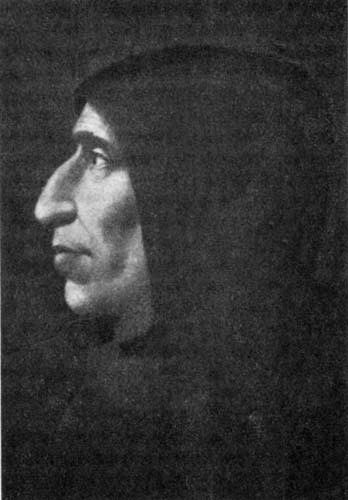
From a painting by Fra Bartolommeo
From 1498 is his famous portrait of Savonarola, now in the Museo Nazionale di San Marco in Florence. The following year he was commissioned a fresco of the Universal Judgement for the Ospedale di Santa Maria Nuova, completed by Albertinelli and Giuliano Bugiardini when Baccio became a Dominican friar on July 26, 1500. The following year he entered the convent of San Marco.
He renounced painting for several years, not resuming until 1504 when he became the head of the monastery workshop in obedience to his superior. In that year he began a Vision of St. Bernard for Bernardo Bianco's family chapel in the Badia Fiorentina, finished in 1507. Soon thereafter, Raphael visited Florence and befriended the friar. Bartolomeo learned perspective from the younger artist, while Raphael added skills in coloring and handling of drapery, which was noticeable in the works he produced after their meeting. With Raphael, he remained on the friendliest terms, and when he departed from Rome, left in his hands two unfinished pictures which Raphael completed.
At the beginning of 1508 Bartolomeo moved to Venice to paint a Holy Father, St. Mary Magdalene and St. Catherine of Siena for the Dominicans of San Pietro Martire in Murano, influenced somewhat by Venetian colorism. As the Dominicans did not pay the work, he took it back to Lucca, where it can be seen now. Also in Lucca, in the October 1509, he painted by Albertinelli an altarpiece with Madonna and Child with Saints for the local cathedral. On November 26, 1510 Pier Soderini commissioned him an altarpiece for the Sala del Consiglio of Florence, now in the Museum of San Marco. Two years later he finished another altarpiece for the cathedral of Besançon.
In 1513 he went to Rome, where he painted a Peter and Paul, now in the Pinacoteca Vaticana, while from the following years are the St. Mark Evangelist of Palazzo Pitti in Florence and the frescoes in the Dominican convent of Pian di Mugnone. After a promised Feast of Venus for Duke Alfonso I d'Este of Ferrara, of which only drawings remain, his last work is fresco of Noli me tangere also in Pian di Mugnone.
He died in Florence in 1517.
Evaluation
Initially, his works showed the influence of Rosselli's assistant, Piero di Cosimo, and those of Domenico Ghirlandaio and Filippino Lippi. After his hiatus from 1500 to 1503, he seemed to change vision, taking from Raphael the representation of light and its effects over moving shapes.
Fra Bartolomeo's figures are generally small and draped. These qualities were alleged against him as defects, and to prove that his style was not the result of want of power, he painted the magnificent figure of the St. Mark Evangelist (ranked as his masterpiece), and the undraped figure of Saint Sebastian. It is alleged that the latter was felt to be so strongly expressive of suffering and agony, that it was found necessary to remove it from the place where it had been exhibited in the chapel of a convent.
Fra Bartolomeo's compositions are remarkable for skill in the massing of light and shade, richness and delicacy of colouring, and for the admirable drapery of the figures, Bartolomeo having been the first to introduce and use the lay-figure with joints.
Among his pupils were Cecchino del Frate, Benedetto Ciamfanini, Gabriel Rustici, Ridolfo Ghirlandaio (the son of Domenico Ghirlandaio), and Fra Paolo Pistolese.[1]
Works
Assumption of Mary (1508) - Oil on canvas, Kaiser – Friedrich – Museum, Berlin (destroyed in 1945)
Madonna in Glory with Saints (1512, with Albertinelli) - Oil on canvas, Cathedral of Besançon
Holy Conversation (1512) - Oil on canvas,
Christ Supported by Two Angels (c. 1514) - Oil on canvas, Casa Vasari, Arezzo
St. Sebastian (1515) - Oil on canvas, Alaffre Collection, Bezenas, France
Sources
Vaughn, William (2000). Encyclopedia of Artists. Oxford University Press, Inc. ISBN 0-19-521572-9.
References
Chris Fischer, Fra Bartolommeo: Master Draughtsman of the High Renaissance (1991-12-02) Publisher : Museum Boijmans van Beuningen (January 1, 1757), ASIN : B01K0SRDJM
Vasari, Vite, Terza Parte.
----
Fine Art Prints | Greeting Cards | Phone Cases | Lifestyle | Face Masks | Men's , Women' Apparel | Home Decor | jigsaw puzzles | Notebooks | Tapestries | ...
----
Artist
A - B - C - D - E - F - G - H - I - J - K - L - M -
N - O - P - Q - R - S - T - U - V - W - X - Y - Z
Retrieved from "http://en.wikipedia.org/"
All text is available under the terms of the GNU Free Documentation License



